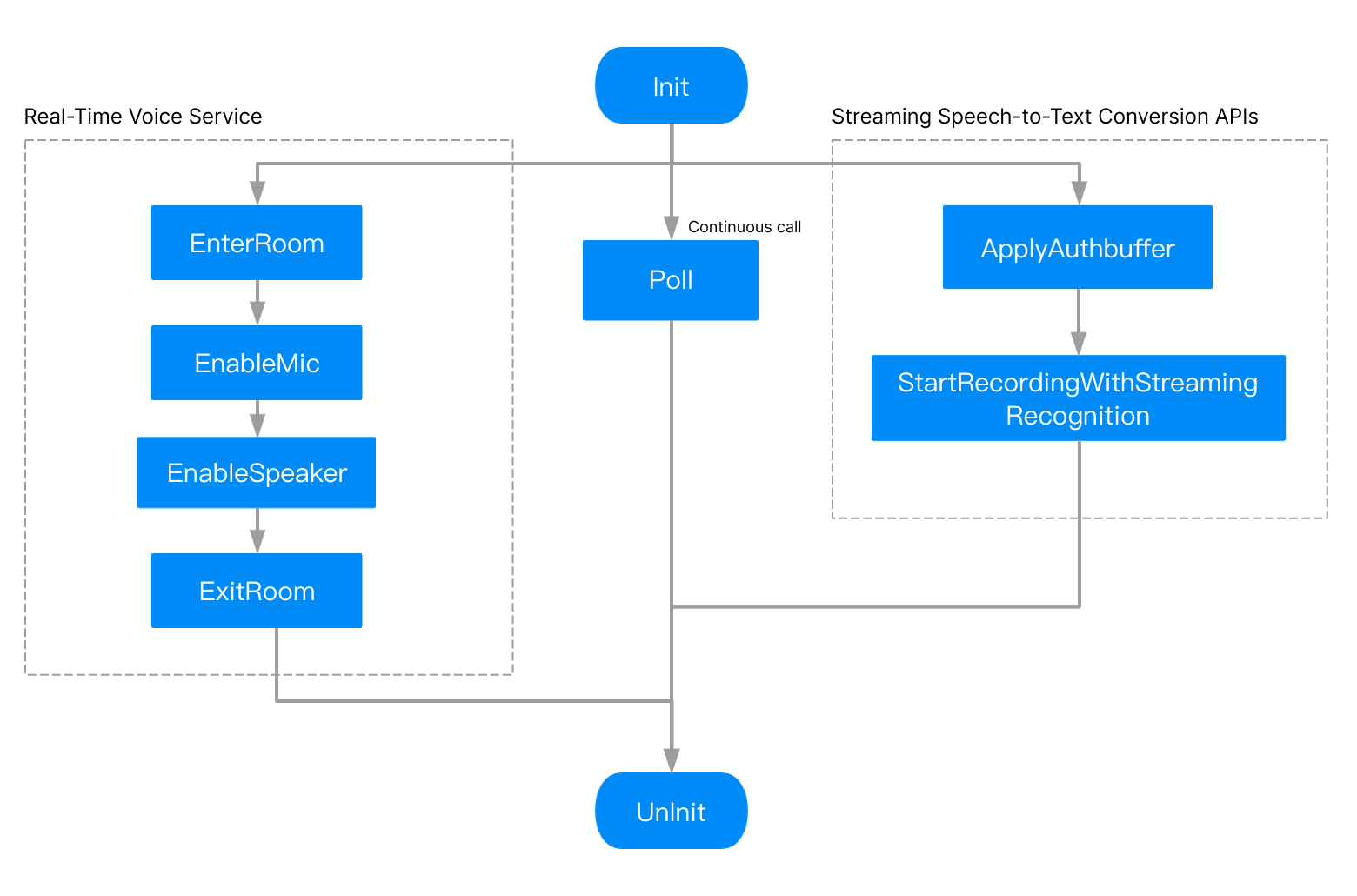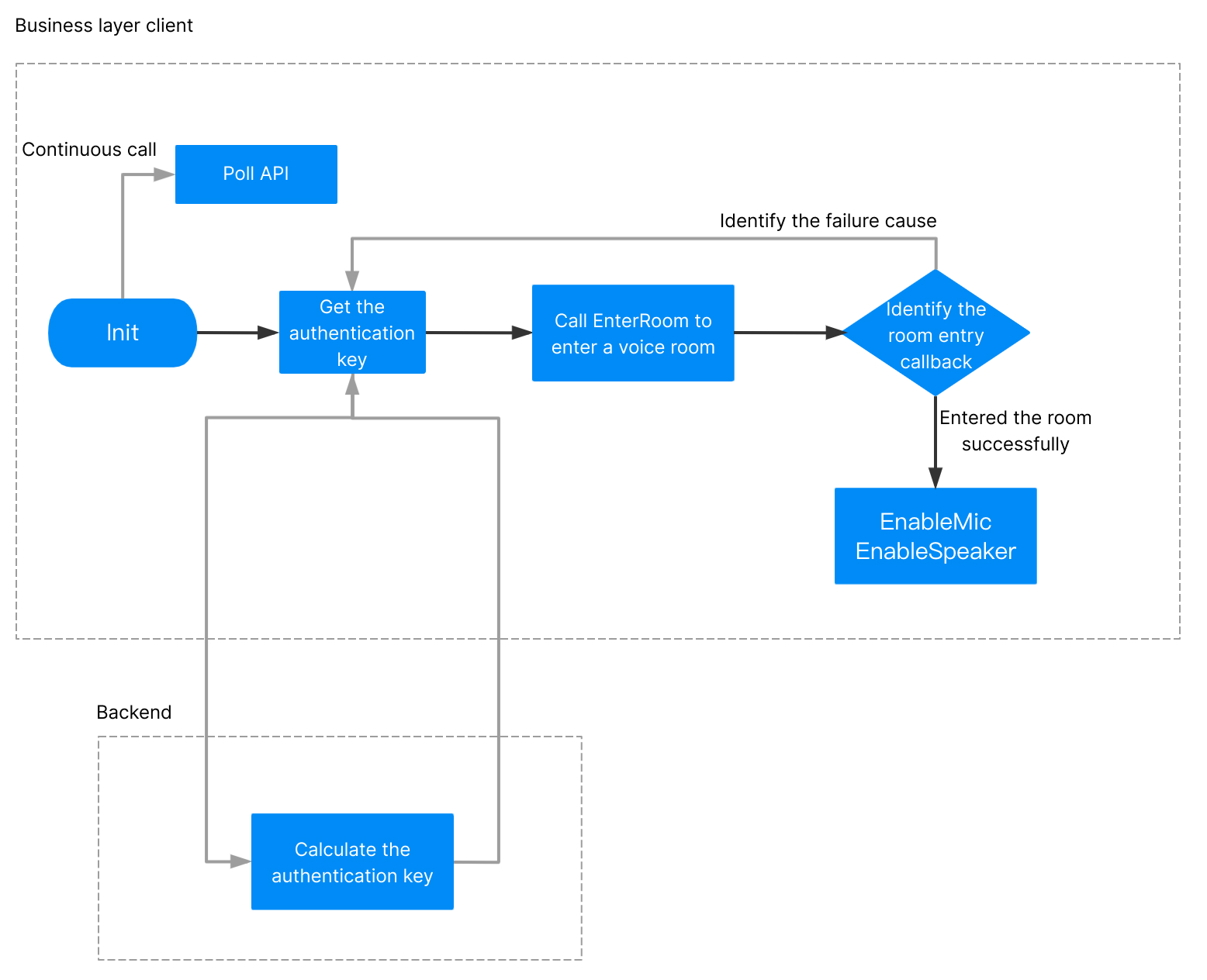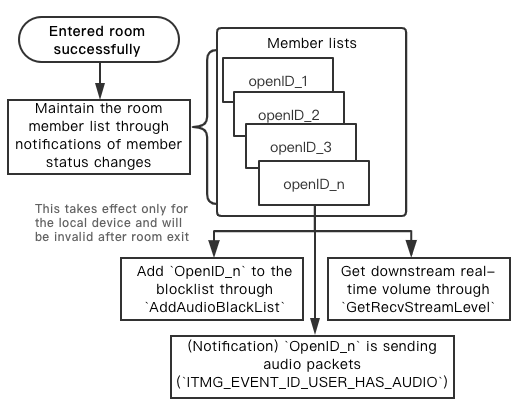实时语音
最后更新时间:2024-01-18 15:02:24
为方便 Unity 开发者调试和接入腾讯云游戏多媒体引擎客户端 API,本文为您介绍适用于 Unity 实时语音功能的开发接入技术文档。
使用 GME 重要事项
GME 提供实时语音服务、语音消息服务及转文本服务,使用 GME 服务都依赖 Init 和 Poll 等核心接口。
重点提示
已完成 GME 应用创建,并获取 SDK AppID 和 Key。请参见 服务开通指引。
已开通 GME 实时语音服务、语音消息服务以及转文本服务。请参见 服务开通指引。
GME 使用前请对工程进行配置,否则 SDK 不生效。
GME 的接口调用成功后返回值为 QAVError.OK,数值为 0。
GME 的接口调用要在同一个线程下。
GME 需要周期性的调用 Poll 接口触发事件回调。
错误码详情可参见 错误码。
GME 在 Unity-WebGL 平台只支持简易的实时语音通话功能,具体参见 H5 工程配置。
接入 SDK
重要步骤
接入 SDK 重要流程如下:


1. 初始化 GME
2. 周期性调用 Poll 触发回调
3. 进入实时语音房间
4. 打开麦克风
5. 打开扬声器
6. 退出语音房间
7. 反初始化 GME
C# 类
类 | 含义 |
ITMGContext | 核心接口 |
ITMGRoom | 房间相关接口 |
ITMGRoomManager | 房间管理接口 |
ITMGAudioCtrl | 音频相关接口 |
ITMGAudioEffectCtrl | 音效及伴奏相关接口 |
核心接口
接口 | 接口含义 |
Init | 初始化 GME |
Poll | 触发事件回调 |
Pause | 系统暂停 |
Resume | 系统恢复 |
Uninit | 反初始化 GME |
引用头文件
using GME;
获取实例
请使用 ITMGContext 的方法获取 Context 实例,不要直接使用 QAVContext.GetInstance() 去获取实例。
初始化 SDK
未初始化前,SDK 处于未初始化阶段,需要通过接口 Init 初始化 SDK,才可以使用实时语音服务、语音消息服务及转文本服务。调用 Init 接口的线程必须于其他接口在同一线程,建议都在主线程调用接口。
接口原型
//class ITMGContextpublic abstract int Init(string sdkAppID, string openID);
返回值
返回值 | 处理 |
QAVError.OK= 0 | 初始化 SDK 成功 |
AV_ERR_SDK_NOT_FULL_UPDATE=7015 | 检查 SDK 文件是否完整,建议删除后重新导入 SDK |
关于7015错误提示:
7015错误码是通过 md5 进行判断,在接入过程中若出现此错误,请根据提示检查 SDK 文件是否完整、SDK 文件版本是否一致。
出现返回值 AV_ERR_SDK_NOT_FULL_UPDATE 时,此返回值只有提示作用,并不会造成初始化失败。
由于第三方加固、Unity 打包机制等因素会影响库文件 md5,造成误判,所以正式发布请在逻辑中忽略此错误,并尽量不在 UI 中提示。
示例代码
int ret = ITMGContext.GetInstance().Init(sdkAppId, openID);//通过返回值判断是否初始化成功if (ret != QAVError.OK){Debug.Log("SDK初始化失败:"+ret);return;}
触发事件回调
通过在 update 里面周期的调用 Poll 可以触发事件回调。Poll 是 GME 的消息泵,GME 需要周期性的调用 Poll 接口触发事件回调。如果没有调用 Poll ,将会导致整个 SDK 服务运行异常。详情请参见 Sample Project 中的 EnginePollHelper 文件。
务必周期性调用 Poll 接口:
务必周期性调用 Poll 接口且在主线程调用,以免接口回调异常。
接口原型
ITMGContext public abstract int Poll();
示例代码
public void Update(){ITMGContext.GetInstance().Poll();}
系统暂停
当系统发生 Pause 事件时,需要同时通知引擎进行 Pause。例如在应用退后台时候(OnApplicationPause, isPause=True),如果不需要后台播放房间内声音,请调用 Pause 接口暂停整个 GME 服务。
接口原型
ITMGContext public abstract int Pause()
系统恢复
当系统发生 Resume 事件时,需要同时通知引擎进行 Resume。Resume 接口只恢复实时语音。
接口原型
ITMGContext public abstract int Resume()
反初始化 SDK
反初始化 SDK,进入未初始化状态。如果游戏业务侧账号与 openid 是绑定的,那切换游戏账号需要反初始化 GME,再用新的 openid 初始化。
接口原型
ITMGContext public abstract int Uninit()
实时语音房间相关接口


接口 | 接口含义 |
GenAuthBuffer | 本地鉴权计算 |
EnterRoom | 加入房间 |
ExitRoom | 退出房间 |
IsRoomEntered | 判断是否已经进入房间 |
SwitchRoom | 快速切换房间 |
本地鉴权计算
接口原型
QAVAuthBuffer GenAuthBuffer(int appId, string roomId, string openId, string key)
参数 | 类型 | 含义 |
appId | int | 来自腾讯云控制台的 AppID 号码 |
roomId | string | 房间号,最大支持127字符 |
openId | string | 用户标识。与 Init 时候的 openID 相同 |
key | string |
示例代码
public static byte[] GetAuthBuffer(string AppID, string RoomID,string OpenId, string AuthKey){return QAVAuthBuffer.GenAuthBuffer(int.Parse(AppID), RoomID, OpenId, AuthKey);}
WebGL 端适配
WebGL 平台下,调用本地鉴权函数后,鉴权值是保存在js代码中,并没有将鉴权的authBuffer返回给c#层,用户在调用 GetAuthBuffer 接口本地鉴权后,进入房间时调用的接口参数中,鉴权参数填空或任意值。
如果使用后台计算鉴权的方案,则不需要调用 GetAuthBuffer 接口。
加入房间
用生成的鉴权信息进房,加入房间默认不打开麦克风及扬声器。
注意:
加入房间事件回调结果 result 为 0 代表进房成功,进房接口 EnterRoom 返回值为 0 不代表进房成功。
房间的音频类型由第一个进房的人确定,此后房间里有成员修改房间类型,将对此房间所有成员生效。例如第一个进入房间的人使用的房间音频类型是流畅音质,第二个进房的是即使进房时候调用接口的音频类型参数是高清音质,进入房间之后也会变成流畅音质。需要有成员调用 ChangeRoomType 才会修改房间的音频类型。
接口原型
ITMGContext EnterRoom(string roomId, int roomType, byte[] authBuffer)
参数 | 类型 | 含义 |
roomId | string | 房间号,最大支持127字符 |
roomType | ITMGRoomType | |
authBuffer | Byte[] | 鉴权码 |
示例代码
ITMGContext.GetInstance().EnterRoom(strRoomId, ITMGRoomType.ITMG_ROOM_TYPE_FLUENCY, byteAuthbuffer);
加入房间事件回调
加入房间完成后会通过回调返回进房结果,监听进房结果事件后进行处理。如果回调为成功,即此时进房成功,开始进行计费。
接口原型
public delegate void QAVEnterRoomComplete(int result, string error_info);public abstract event QAVEnterRoomComplete OnEnterRoomCompleteEvent;
示例代码
//对事件进行监听:ITMGContext.GetInstance().OnEnterRoomCompleteEvent += new QAVEnterRoomComplete(OnEnterRoomComplete);//监听处理:void OnEnterRoomComplete(int err, string errInfo){if (err != 0) {ShowLoginPanel("错误码:" + err + " 错误信息:" + errInfo);return;}else{//进房成功}}
Data 详情
消息 | Data | 例子 |
ITMG_MAIN_EVENT_TYPE_ENTER_ROOM | result; error_info | {"error_info":"","result":0} |
ITMG_MAIN_EVENT_TYPE_ROOM_DISCONNECT | result; error_info | {"error_info":"waiting timeout, please check your network","result":0} |
如果断网,将会有断网的回调提示
ITMG_MAIN_EVENT_TYPE.ITMG_MAIN_EVENT_TYPE_ROOM_DISCONNECT,此时 SDK 会自动进行重连,回调是 ITMG_MAIN_EVENT_TYPE_RECONNECT_START,当重连成功时,会有 ITMG_MAIN_EVENT_TYPE_RECONNECT_SUCCESS 回调。错误码
错误码值 | 原因及建议方案 |
7006 | 鉴权失败原因: AppID 不存在或者错误 authbuff 鉴权错误 鉴权过期 OpenId 不符合规范 |
7007 | 已经在其它房间 |
1001 | 已经在进房过程中,然后又重复了此操作。建议在进房回调返回之前不要再调用进房接口 |
1003 | 已经进房了在房间中,又调用一次进房接口 |
1101 | 确保已经初始化 SDK,确保 OpenId 是否符合规则,或者确保在同一线程调用接口,以及确保 Poll 接口正常调用 |
退出房间
通过调用此接口可以退出所在房间。这是一个异步接口,返回值为 AV_OK 的时候代表异步投递成功。如果应用中有退房后立即进房的场景,在接口调用流程上,开发者无需要等待 ExitRoom 的回调 RoomExitComplete 通知,只需直接调用接口。
接口原型
ITMGContext ExitRoom()
示例代码
ITMGContext.GetInstance().ExitRoom();
退出房间事件回调
退出房间完成回调,通过委托传递消息。
接口原型
public delegate void QAVExitRoomComplete();public abstract event QAVExitRoomComplete OnExitRoomCompleteEvent;
示例代码
对事件进行监听:ITMGContext.GetInstance().OnExitRoomCompleteEvent += new QAVExitRoomComplete(OnExitRoomComplete);监听处理:void OnExitRoomComplete(){//退出房间后的处理}
判断是否已经进入房间
通过调用此接口可以判断是否已经进入房间,返回值为 bool 类型。请勿在进房过程中调用。
接口原型
ITMGContext abstract bool IsRoomEntered()
示例代码
ITMGContext.GetInstance().IsRoomEntered();
快速切换房间
调用此接口快速切换实时语音房间。此接口在进房后调用。切换房间后,不重置设备,即如果在此房间已经是打开麦克风状态,在切换房间后也会是打开麦克风状态。
快速切换房间的回调是 ITMG_MAIN_EVENT_TYPE.ITMG_MAIN_EVENT_TYPE_SWITCH_ROOM,字段是 error_info 以及 result。
接口原型
public abstract int SwitchRoom(string targetRoomID, byte[] authBuffer);
类型说明
参数 | 类型 | 含义 |
targetRoomID | String | 将要进入的房间号 |
authBuffer | byte[] | 用将要进入的房间号生成的新鉴权 |
房间内状态维护
此部分接口用于业务层显示说话成员、进退房成员,以及将房间内某成员禁言等功能。


接口/通知 | 含义 |
ITMG_MAIN_EVNET_TYPE_USER_UPDATE | 成员状态变化通知 |
AddAudioBlackList | 房间中禁言某成员 |
RemoveAudioBlackList | 移除禁言 |
成员进房、说话状态通知事件
该事件适用于获取房间中说话的人并在 UI 中展示,以及有人进入、退出语音房间的一个通知。
该事件在状态变化才通知,状态不变化的情况下不通知。如需实时获取成员状态,请在业务层收到通知时缓存,事件消息为 ITMG_MAIN_EVNET_TYPE_USER_UPDATE,包含 event_id、count 及 openIdList,在 OnEvent 通知中对事件消息进行判断。
音频事件 EVENT_ID_ENDPOINT_NO_AUDIO 的通知有一个阈值,超过这个阈值才会发送通知。即本端两秒没采集到声音后, 房间其他成员才收到本端停止说话的通知。
音频事件只会返回成员说话状态,没有返回具体的音量。如需房间内成员具体音量可使用接口 GetRecvStreamLevel 进行获取。
event_id | 含义 | 应用侧维护内容 |
EVENT_ID_ENDPOINT_ENTER | 有成员进入房间,返回此时进房的 openid | 应用侧维护成员列表 |
EVENT_ID_ENDPOINT_EXIT | 有成员退出房间,返回此时退房的 openid | 应用侧维护成员列表 |
EVENT_ID_ENDPOINT_HAS_AUDIO | 有成员发送音频包,返回此时房间内说话的 openid,通过此事件可以判断用户是否说话,并展示声纹效果 | 应用侧维护通话成员列表 |
EVENT_ID_ENDPOINT_NO_AUDIO | 有成员停止发送音频包,返回此时房间内停止说话的 openid | 应用侧维护通话成员列表 |
示例代码
public delegate void QAVEndpointsUpdateInfo(int eventID, int count, [MarshalAs(UnmanagedType.LPArray, SizeParamIndex = 1)]string[] openIdList);public abstract event QAVEndpointsUpdateInfo OnEndpointsUpdateInfoEvent;//对事件进行监听:ITMGContext.GetInstance().OnEndpointsUpdateInfoEvent += new QAVEndpointsUpdateInfo(OnEndpointsUpdateInfo);//监听处理:void OnEndpointsUpdateInfo(int eventID, int count, string[] openIdList){//进行处理switch (eventID){case EVENT_ID_ENDPOINT_ENTER://有成员进入房间break;case EVENT_ID_ENDPOINT_EXIT://有成员退出房间break;case EVENT_ID_ENDPOINT_HAS_AUDIO://有成员发送音频包break;case EVENT_ID_ENDPOINT_NO_AUDIO://有成员停止发送音频包break;default:break;}break;}
房间中禁言某成员
将某个 ID 加入音频数据黑名单,即不接受某人的语音, 只对本端生效,不会影响其他端。返回值为 0 表示调用成功。例如 :A、B、C 都在同一个房间开麦说话:
如果 A 设置了 C 的黑名单, 则 A 只能听见 B 的声音。
B 因为没有设置黑名单, 仍旧可以听见 A 和 C 的声音。
C 同样因为没有设置黑名单, 可以听见 A 和 B 的声音。
此接口适用于在语音房间中将某用户禁言的场景。
接口原型
ITMGContext ITMGAudioCtrl AddAudioBlackList(String openId)
参数 | 类型 | 含义 |
openId | String | 需添加黑名单的用户 openid |
示例代码
ITMGContext.GetInstance().GetAudioCtrl ().AddAudioBlackList (openId);
移除禁言
将某个 ID 移除音频数据黑名单。返回值为0表示调用成功。
接口原型
ITMGContext ITMGAudioCtrl RemoveAudioBlackList(string openId)
参数 | 类型 | 含义 |
openId | String | 需移除黑名单的用户 openid |
示例代码
ITMGContext.GetInstance().GetAudioCtrl ().RemoveAudioBlackList (openId);
实时语音采集相关接口
初始化 SDK 之后进房,在房间中,才可以调用实时音频语音相关接口。
当用户界面单击打开/关闭麦克风/扬声器按钮时,建议采用 EnableMic 以及 EnableSpeaker 接口进行调用。
当用户界面按住麦克风按钮时发言,放开按钮不发言,建议采用进房时候调用 EnableAudioCaptureDevice 一次,后续按住发言调用 EnableAudioSend 来实现。
接口 | 接口含义 |
EnableMic | 开关麦克风 |
GetMicState | 获取麦克风状态 |
EnableAudioCaptureDevice | 开关采集设备 |
IsAudioCaptureDeviceEnabled | 获取采集设备状态 |
EnableAudioSend | 打开关闭音频上行 |
IsAudioSendEnabled | 获取音频上行状态 |
GetMicLevel | 获取实时麦克风音量 |
GetSendStreamLevel | 获取音频上行实时音量 |
SetMicVolume | 设置麦克风音量 |
GetMicVolume | 获取麦克风音量 |
开启或关闭麦克风
此接口用来开启关闭麦克风。加入房间默认不打开麦克风及扬声器。EnableMic = EnableAudioCaptureDevice + EnableAudioSend
接口原型
ITMGAudioCtrl EnableMic(bool isEnabled)
参数 | 类型 | 含义 |
isEnabled | boolean | 如果需要打开麦克风,则传入的参数为 true,如果关闭麦克风,则参数为 false |
示例代码
//打开麦克风ITMGContext.GetInstance().GetAudioCtrl().EnableMic(true);
麦克风状态获取
此接口用于获取麦克风状态,返回值0为关闭麦克风状态,返回值1为打开麦克风状态。
接口原型
ITMGAudioCtrl GetMicState()
示例代码
micToggle.isOn = ITMGContext.GetInstance().GetAudioCtrl().GetMicState();
开启或关闭采集设备
此接口用来开启/关闭采集设备。加入房间默认不打开设备。
只能在进房后调用此接口,退房会自动关闭设备。
在移动端,打开采集设备通常会伴随权限申请,音量类型调整等操作。
接口原型
ITMGAudioCtrl int EnableAudioCaptureDevice(bool isEnabled)
参数 | 类型 | 含义 |
isEnabled | bool | 如果需要打开采集设备,则传入的参数为 true,如果关闭采集设备,则参数为 false |
示例代码
//打开采集设备ITMGContext.GetInstance().GetAudioCtrl().EnableAudioCaptureDevice(true);
采集设备状态获取
此接口用于采集设备状态获取。
接口原型
ITMGAudioCtrl bool IsAudioCaptureDeviceEnabled()
示例代码
bool IsAudioCaptureDevice = ITMGContext.GetInstance().GetAudioCtrl().IsAudioCaptureDeviceEnabled();
打开或关闭音频流发送
此接口用于打开/关闭音频流发送。如果采集设备已经打开,那么会发送采集到的音频数据。如果采集设备没有打开,那么仍旧无声。采集设备的打开关闭请参见接口 EnableAudioCaptureDevice。
接口原型
ITMGAudioCtrl int EnableAudioSend(bool isEnabled)
参数 | 类型 | 含义 |
isEnabled | bool | 如果需要打开音频上行,则传入的参数为 true,如果关闭音频上行,则参数为 false |
示例代码
ITMGContext.GetInstance().GetAudioCtrl().EnableAudioSend(true);
音频流发送状态获取
此接口用于音频流发送状态获取。
接口原型
ITMGAudioCtrl bool IsAudioSendEnabled()
示例代码
bool IsAudioSend = ITMGContext.GetInstance().GetAudioCtrl().IsAudioSendEnabled();
获取麦克风实时音量
此接口用于获取麦克风实时音量,返回值为 int 类型。建议20ms获取一次。值域为0 - 100,通过此接口可以获取到麦克风采集到的实时音量情况。
接口原型
ITMGAudioCtrl int GetMicLevel
示例代码
ITMGContext.GetInstance().GetAudioCtrl().GetMicLevel();
获取音频流发送实时音量
此接口用于获取自己音频流发送实时音量,返回值为 int 类型,取值范围为0 - 100。
接口原型
ITMGAudioCtrl int GetSendStreamLevel()
示例代码
int Level = ITMGContext.GetInstance().GetAudioCtrl().GetSendStreamLevel();
设置麦克风软件音量
此接口用于设置麦克风的音量。参数 volume 用于设置麦克风的音量,相当于对采集的声音做衰减或增益。
接口原型
ITMGAudioCtrl SetMicVolume(int volume)
参数 | 类型 | 含义 |
volume | int | 取值范围为 0-200,数值为0的时候表示静音,当数值为100的时候表示音量不增不减,默认数值为100 |
示例代码
int micVol = (int)(value * 100);ITMGContext.GetInstance().GetAudioCtrl().SetMicVolume (micVol);
获取麦克风软件音量
此接口用于获取麦克风的音量。返回值为一个 int 类型数值,返回值为101代表没调用过接口 SetMicVolume。
接口原型
ITMGAudioCtrl GetMicVolume()
示例代码
ITMGContext.GetInstance().GetAudioCtrl().GetMicVolume();
实时语音播放相关接口
接口 | 接口含义 |
EnableSpeaker | 开关扬声器 |
GetSpeakerState | 获取扬声器状态 |
EnableAudioPlayDevice | 开关播放设备 |
IsAudioPlayDeviceEnabled | 获取播放设备状态 |
EnableAudioRecv | 打开关闭音频下行 |
IsAudioRecvEnabled | 获取音频下行状态 |
GetSpeakerLevel | 获取实时扬声器音量 |
GetRecvStreamLevel | 获取房间内其他成员下行实时音量 |
SetSpeakerVolume | 设置扬声器音量 |
GetSpeakerVolume | 获取扬声器音量 |
开启或关闭扬声器
此接口用于开启关闭扬声器。EnableSpeaker = EnableAudioPlayDevice + EnableAudioRecv
接口原型
ITMGAudioCtrl EnableSpeaker(bool isEnabled)
参数 | 类型 | 含义 |
isEnabled | bool | 如果需要关闭扬声器,则传入的参数为 false,如果打开扬声器,则参数为 true |
示例代码
//打开扬声器ITMGContext.GetInstance().GetAudioCtrl().EnableSpeaker(true);
扬声器状态获取
此接口用于扬声器状态获取。返回值0为关闭扬声器状态,返回值1为打开扬声器状态。
接口原型
ITMGAudioCtrl GetSpeakerState()
示例代码
speakerToggle.isOn = ITMGContext.GetInstance().GetAudioCtrl().GetSpeakerState();
开启或关闭播放设备
此接口用于开启关闭播放设备。
接口原型
ITMGAudioCtrl EnableAudioPlayDevice(bool isEnabled)
参数 | 类型 | 含义 |
isEnabled | bool | 如果需要关闭播放设备,则传入的参数为 false,如果打开播放设备,则参数为 true |
示例代码
ITMGContext.GetInstance().GetAudioCtrl().EnableAudioPlayDevice(true);
播放设备状态获取
此接口用于播放设备状态获取。
接口原型
ITMGAudioCtrl bool IsAudioPlayDeviceEnabled()
示例代码
bool IsAudioPlayDevice = ITMGContext.GetInstance().GetAudioCtrl().IsAudioPlayDeviceEnabled();
打开或关闭音频流接收
此接口用于打开/关闭音频流接收。如果播放设备已经打开,那么会播放房间里其他人的音频数据。如果播放设备没有打开,那么仍旧无声。播放设备的打开关闭参见接口请参见 EnableAudioPlayDevice。
接口原型
ITMGAudioCtrl int EnableAudioRecv(bool isEnabled)
参数 | 类型 | 含义 |
isEnabled | bool | 如果需要打开音频下行,则传入的参数为 true,如果关闭音频下行,则参数为 false |
示例代码
ITMGContext.GetInstance().GetAudioCtrl().EnableAudioRecv(true);
音频流接收状态获取
此接口用于音频流接收状态获取。
接口原型
ITMGAudioCtrl bool IsAudioRecvEnabled()
示例代码
bool IsAudioRecv = ITMGContext.GetInstance().GetAudioCtrl().IsAudioRecvEnabled();
获取扬声器实时音量
此接口用于获取扬声器实时音量。返回值为 int 类型数值,表示扬声器实时音量。建议20ms获取一次。
接口原型
ITMGAudioCtrl GetSpeakerLevel()
示例代码
ITMGContext.GetInstance().GetAudioCtrl().GetSpeakerLevel();
获取房间内其他成员音频流音量
此接口用于获取接收到的房间内其他成员音频流实时音量,返回值为 int 类型,取值范围为0 - 200。
接口原型
ITMGAudioCtrl int GetRecvStreamLevel(string openId)
参数 | 类型 | 含义 |
openId | string | 房间其他成员的 OpenID |
示例代码
int Level = ITMGContext.GetInstance().GetAudioCtrl().GetRecvStreamLevel(openId);
动态设置房间内某成员音量
此接口用于设置房间内某成员的说话音量大小,此设置只在本端生效。
接口原型
public abstract int SetSpeakerVolumeByOpenID(string openid, int volume);
参数 | 类型 | 含义 |
openId | String | 需要调节音量大小的 OpenID |
volume | int | 百分比,建议[0-200],其中100为默认值 |
设置扬声器的音量
此接口用于设置扬声器的音量。
接口原型
ITMGAudioCtrl SetSpeakerVolume(int volume)
参数 | 类型 | 含义 |
volume | int | 设置音量,范围0 - 200,当数值为0时,表示静音,当数值为100时,表示音量不增不减,默认数值为100 |
示例代码
int speVol = (int)(value * 100);ITMGContext.GetInstance().GetAudioCtrl().SetSpeakerVolume(speVol);
获取扬声器的音量
此接口用于获取扬声器的音量。返回值为 int 类型数值,代表扬声器的音量,返回值为101代表没调用过接口 SetSpeakerVolume。
Level 是实时音量,Volume 是扬声器的音量,最终声音音量 = Level × Volume %。例如实时音量是数值是100,此时 Volume 的数值是60,那么最终发出来的声音数值也是60。
接口原型
ITMGAudioCtrl GetSpeakerVolume()
示例代码
ITMGContext.GetInstance().GetAudioCtrl().GetSpeakerVolume();
设备选择相关接口
设备选择相关接口只能在 PC 端上使用。
接口 | 接口含义 |
GetMicListCount | 获取麦克风设备数量 |
GetMicList | 枚举麦克风设备 |
GetSpeakerListCount | 获取扬声器设备数量 |
GetSpeakerList | 枚举扬声器设备 |
SelectMic | 选定麦克风设备 |
SelectSpeaker | 选定扬声器设备 |
获取麦克风设备数量
此接口用来获取麦克风设备数量。
函数原型
public abstract int GetMicListCount()
示例代码
ITMGContext.GetInstance().GetAudioCtrl().GetMicListCount();
枚举麦克风设备
此接口用来枚举麦克风设备。配合 GetMicListCount 接口使用。
函数原型
public abstract int GetMicList(out List<TMGAudioDeviceInfo> devicesInfo, int count)
参数 | 类型 | 含义 |
ppDeviceInfoList | TMGAudioDeviceInfo | 设备列表 |
count | int | 获取的麦克风设备数量 |
TMGAudioDeviceInfo 参数 | 类型 | 含义 |
m_strDeviceID | string | 设备名称 |
m_strDeviceID | string | 设备 ID |
示例代码
ITMGContext.GetInstance().GetAudioCtrl().GetMicList(devicesInfo,count);
选中麦克风设备
此接口用来选中麦克风设备。如果不调用或者传入 "DEVICEID_DEFAULT",则选中系统默认设备。
GetMicList接口中返回的第0个设备 id 为默认设备,未选中设备时通话设备为默认设备,选中后业务层维护通话设备。如果该通话设备被拔出,则此时通话设备为默认设备,拔出的通话设备插入后,此时通话设备恢复为插入的通话设备。
函数原型
public abstract int SelectMic(string micID);
参数 | 类型 | 含义 |
pMicID | string | 麦克风设备 ID,设备 ID 来自于 GetMicList 返回列表 |
示例代码
string deviceID = DEVICE_ID_DEFAULT;if (index != 0){deviceID = listMicInfo[index - 1].m_strDeviceID;}ITMGContext.GetInstance().GetAudioCtrl().SelectMic(deviceID);selectedMicID = deviceID;
此接口用来获取扬声器设备数量。
函数原型
public abstract int GetSpeakerListCount();
示例代码
ITMGContext.GetInstance().GetAudioCtrl().GetSpeakerListCount();
枚举扬声器设备
此接口用来枚举扬声器设备。配合 GetSpeakerListCount 接口使用。
函数原型
public abstract int GetSpeakerList(out List<TMGAudioDeviceInfo> devicesInfo, int count)
参数 | 类型 | 含义 |
ppDeviceInfoList | TMGAudioDeviceInfo | 设备列表 |
count | int | 获取的扬声器设备数量 |
TMGAudioDeviceInfo 参数 | 类型 | 含义 |
m_strDeviceID | string | 设备名称 |
m_strDeviceID | string | 设备 ID |
示例代码
int speakerCount = ITMGContext.GetInstance().GetAudioCtrl().GetSpeakerListCount();Debug.LogFormat("speakerCount = {0}", speakerCount);if (speakerCount > 0){int ret = ITMGContext.GetInstance().GetAudioCtrl().GetSpeakerList(out listSpeakerInfo, speakerCount);Debug.LogFormat("GetSpeakerList ret = {0}", ret);if (ret != 0){listSpeakerInfo = null;}}}
选中扬声器设备
此接口用来选中播放设备。如果不调用或者传入 "DEVICEID_DEFAULT",则选中系统默认播放设备。
函数原型
public abstract int SelectSpeaker(string speaker);
参数 | 类型 | 含义 |
speaker | string | 扬声器设备 ID,设备 ID 来自于 GetSpeakerList 返回列表 |
示例代码
speakerDropdown = transform.Find("DevicePanel/SpeakerSelect").GetComponent<Dropdown>();if (speakerDropdown != null){speakerDropdown.onValueChanged.AddListener(delegate (int index){string deviceID = DEVICE_ID_DEFAULT;if (index != 0){deviceID = listSpeakerInfo[index - 1].m_strDeviceID;}ITMGContext.GetInstance().GetAudioCtrl().SelectSpeaker(deviceID);selectedSpeakerID = deviceID;});}
特殊接口
启动耳返
此接口用于启动耳返,需要 EnableLoopBack+EnableSpeaker 才可以听到自己声音。
接口原型
ITMGContext GetAudioCtrl EnableLoopBack(bool enable)
参数 | 类型 | 含义 |
enable | bool | 设置是否启动 |
示例代码
ITMGContext.GetInstance().GetAudioCtrl().EnableLoopBack(true);
设备占用和释放事件回调
在房间内,占用设备和释放设备时会回调,通过委托传递事件的相关消息。
public delegate void QAVOnDeviceStateChangedEvent(int deviceType, string deviceId, bool openOrClose);public abstract event QAVOnDeviceStateChangedEvent OnDeviceStateChangedEvent;
参数 | 类型 | 含义 |
deviceType | int | 1 代表采集设备 2 代表播放设备 |
deviceId | string | 设备 GUID,用于标记设备,仅在 Windows 端和 Mac 端有效 |
openOrClose | bool | 采集设备/播放设备占用或者释放 |
示例代码
对事件进行监听:ITMGContext.GetInstance().GetAudioCtrl().OnDeviceStateChangedEvent += new QAVAudioDeviceStateCallback(OnAudioDeviceStateChange);监听处理:void QAVAudioDeviceStateCallback(int deviceType, string deviceId, bool openOrClose){//设备占用和释放事件相关回调处理}
获取用户房间音频类型
此接口用于获取用户房间音频类型,返回值为房间音频类型,返回值为0时代表获取用户房间音频类型发生错误,房间音频类型参考 EnterRoom 接口。
接口原型
ITMGContext ITMGRoom public int GetRoomType()
示例代码
ITMGContext.GetInstance().GetRoom().GetRoomType();
房间类型修改
此接口用于修改用户房间音频类型,结果参见回调事件,事件类型为 ITMG_MAIN_EVENT_TYPE_CHANGE_ROOM_TYPE。房间的音频类型由第一个进房的人确定,此后房间里有成员修改房间类型,将对此房间所有成员生效。
接口原型
ITMGContext ITMGRoom public int ChangeRoomType(ITMGRoomType roomtype)
参数 | 类型 | 含义 |
roomtype | ITMGRoomType | 房间切换成的目标类型,房间音频类型参考 EnterRoom 接口 |
示例代码
ITMGContext.GetInstance().GetRoom().ChangeRoomType(ITMG_ROOM_TYPE_FLUENCY);
回调事件
主动设置房间类型,房间类型设置后,通过委托传递修改完成的相关消息。
返回的参数 | 含义 |
roomtype | 返回切换后的 roomtype 类型 |
public abstract event QAVCallback OnChangeRoomtypeCallback;public abstract event QAVOnRoomTypeChangedEvent OnRoomTypeChangedEvent;
示例代码
//对事件进行监听:ITMGContext.GetInstance ().OnRoomTypeChangedEvent += new QAVOnRoomTypeChangedEvent (OnRoomTypeChangedEvent);//监听处理:void OnRoomTypeChangedEvent(int roomtype){ShowWarnning (string.Format ("RoomTypeChanged current:{0}",roomtype));}
房间类型变化通知
用户主动修改房间类型,或者房间内其它用户修改房间类型,只要房间类型发生变化,就会通过通知事件告知业务层房间类型发生变化,返回的是房间类型,参考 EnterRoom 接口。
public delegate void QAVOnRoomTypeChangedEvent(int roomtype);public abstract event QAVOnRoomTypeChangedEvent OnRoomTypeChangedEvent;
示例代码
//对事件进行监听:ITMGContext.GetInstance().OnRoomTypeChangedEvent += new QAVOnRoomTypeChangedEvent(OnRoomTypeChangedEvent);//监听处理:void OnRoomTypeChangedEvent(int roomtype){//房间类型改变后的处理}
房间通话质量监控事件
质量监控事件,此通知事件适用于监听网络质量,如果用户网络差的话,业务层将通过 UI 提醒用户切换网络。在进房后触发,事件2秒回调一次,事件消息为 ITMG_MAIN_EVENT_TYPE_CHANGE_ROOM_QUALITY,返回的参数为 weight、loss 及 delay,代表的信息如下:
参数 | 类型 | 含义 |
weight | int | 范围是1 - 50,数值为50是音质评分极好,数值为1是音质评分很差,几乎不能使用,数值为0代表初始值,无含义。一般数值在30以下就可以提醒用户网络较差,建议切换网络 |
loss | double | 上行丢包率 |
delay | int | 音频触达延迟时间(ms) |
获取版本号
获取 SDK 版本号,用于分析。
接口原型
ITMGContext abstract string GetSDKVersion()
示例代码
ITMGContext.GetInstance().GetSDKVersion();
设置打印日志等级
用于设置打印日志等级。建议保持默认等级。需要在 Init 之前调用。
接口原型
ITMGContext SetLogLevel(ITMG_LOG_LEVEL levelWrite, ITMG_LOG_LEVEL levelPrint)
参数含义
参数 | 类型 | 含义 |
levelWrite | ITMG_LOG_LEVEL | 设置写入日志的等级,TMG_LOG_LEVEL_NONE 表示不写入,默认为 TMG_LOG_LEVEL_INFO |
levelPrint | ITMG_LOG_LEVEL | 设置打印日志的等级,TMG_LOG_LEVEL_NONE 表示不打印,默认为 TMG_LOG_LEVEL_ERROR |
ITMG_LOG_LEVEL 说明如下:
ITMG_LOG_LEVEL | 含义 |
TMG_LOG_LEVEL_NONE | 不打印日志 |
TMG_LOG_LEVEL_ERROR | 打印错误日志(默认) |
TMG_LOG_LEVEL_INFO | 打印提示日志 |
TMG_LOG_LEVEL_DEBUG | 打印开发调试日志 |
TMG_LOG_LEVEL_VERBOSE | 打印高频日志 |
示例代码
ITMGContext.GetInstance().SetLogLevel(TMG_LOG_LEVEL_INFO,TMG_LOG_LEVEL_INFO);
设置打印日志路径
用于设置打印日志路径。默认路径如下。需要在 Init 之前调用。
平台 | 路径 |
Windows | %appdata%\\Tencent\\GME\\ProcessName |
iOS | Application/xxxxxxxx-xxxx-xxxx-xxxx-xxxxxxxxxxxx/Documents |
Android | /sdcard/Android/data/xxx.xxx.xxx/files |
Mac | /Users/username/Library/Containers/xxx.xxx.xxx/Data/Documents |
接口原型
ITMGContext SetLogPath(string logDir)
参数 | 类型 | 含义 |
logDir | String | 路径 |
示例代码
ITMGContext.GetInstance().SetLogPath(path);
获取诊断信息
获取音视频通话的实时通话质量的相关信息。该接口主要用来查看实时通话质量、排查问题等,业务侧可以忽略。
接口原型
ITMGRoom GetQualityTips()
示例代码
string tips = ITMGContext.GetInstance().GetRoom().GetQualityTips();
文档反馈

